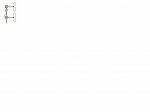Trebleplink
Member
- Joined
- Feb 17, 2016
- Messages
- 13
When I saw a 2 element folded dipole antenna for about $150, I was impressed. But look at this: the designer is getting a 1.5:1 swr over 310 to 480 MHz! This is very impressive - almost an octave. I've done broadband antenna design, and have never been able to achieve this wide swr bandwidth with folded dipoles. Maybe he has synthesized a clever compensating network?
I had to find out. It arrived and appeared to be well made. No elaborate compensation network is used, just a standard 1/2 wave coax balun to transform the 200-300 ohms of the folded dipole to 50-75 ohm feedpoint. It's about 15 inches tall, consistent with the specified 310 MHz low end.
I then noticed that each dipole had no markings about which end is up/down or +/- how does one ensure they're phased the same?
I have a small indoor antenna range which works, but is flawed for serious work by reflections. Nevertheless, I mounted up a dipole and measured it. (when 2 dipoles are used, they terminate in parallel and fed through a provided 25 to 50 ohm quarter-wave line section.)
Turns out, the antenna DOES NOT perform as advertised. No magic here. Looks like the law of physics still applies... From 310 to about 380 MHz, it showed a healthy 1.5:1 swr (within spec) but at 400 MHz, it's 2.5:1. At 430 MHz it's over 3.0:1. At about 480 MHz the swr rises to 4.5:1. For receiving it should kinda work with swr loss and additional line loss caused by excessive swr.
So, I conclude it's a standard 2 element folded dipole antenna designed for 310 to 380 MHz. Aside from lacking polarity markings, looks like a good antenna.
I'm thinking somebody in marketing either made a typographical error (380 vs 480) or decided to fraudulently market it as working1.5:1 to 480 MHz.
One attached file is the VNA scan of 320 to 480 MHz. The red line is swr with the scale at left. Frequency is shown in center. Don't blame the antenna for the small ziggies above 420 MHz - that's indoor reflections at work.



I had to find out. It arrived and appeared to be well made. No elaborate compensation network is used, just a standard 1/2 wave coax balun to transform the 200-300 ohms of the folded dipole to 50-75 ohm feedpoint. It's about 15 inches tall, consistent with the specified 310 MHz low end.
I then noticed that each dipole had no markings about which end is up/down or +/- how does one ensure they're phased the same?
I have a small indoor antenna range which works, but is flawed for serious work by reflections. Nevertheless, I mounted up a dipole and measured it. (when 2 dipoles are used, they terminate in parallel and fed through a provided 25 to 50 ohm quarter-wave line section.)
Turns out, the antenna DOES NOT perform as advertised. No magic here. Looks like the law of physics still applies... From 310 to about 380 MHz, it showed a healthy 1.5:1 swr (within spec) but at 400 MHz, it's 2.5:1. At 430 MHz it's over 3.0:1. At about 480 MHz the swr rises to 4.5:1. For receiving it should kinda work with swr loss and additional line loss caused by excessive swr.
So, I conclude it's a standard 2 element folded dipole antenna designed for 310 to 380 MHz. Aside from lacking polarity markings, looks like a good antenna.
I'm thinking somebody in marketing either made a typographical error (380 vs 480) or decided to fraudulently market it as working1.5:1 to 480 MHz.
One attached file is the VNA scan of 320 to 480 MHz. The red line is swr with the scale at left. Frequency is shown in center. Don't blame the antenna for the small ziggies above 420 MHz - that's indoor reflections at work.





